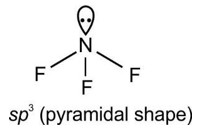What are major differences between covalent and ionic bonds?
What are major differences between covalent and ionic bonds?
-
1 Answer
-
The name of covalent and ionic bonds tell their formation story in small detail. Co- means sharing or coexisting, so whenever there is bond fromation due to sharing of valence electron, it is known as covalent bond. Similerly, ionic bonds suggest that when a bond formation takes place due to ions, which attract each other, it is considered as ionic bond. Ionic bonds are also known as electrovalent bonds. There are some major differences between Electrovalent and covalent bonds. Chekc the table below:
Aspect Covalent Bond Ionic Bond Reason of Formation sharing of electrons between atoms transfer of electrons from one atom to another Elements Usually non-metals with non-metals Usually metals with non-metals Strength Moderate the strongest Nature Directional Bond & Poor conductors of electricity Non-directional Bond & Conducts electricity in aqueous state Electronegativity Difference Small (generally < 1.7) Large (generally > 1.7) Physical State Usually Gases, liquids, and soft solids Hard crystalline solids Melting & Boiling Points low to moderate high Solubility Non-polar solvents Polar solvents like water Examples H? , O? , CH? , HCl, NH? NaCl, KBr, CaCl? , MgO For more detail related to the chemical bonding in class 11 chemistry read our notes.
Similar Questions for you
He2 has zero bond order hence it does not exist.
The three fundamental laws of chemistry are - Law of Definite Proportions, Law of Conservation of Mass, and Law of Multiple Proportions.
The three types of chemical bonds are - ionic, metallic and covalent bonds. When the electrons transfer between the atoms, they form the Ionic bonds by producing charged ions that are attracted to each other. When atoms share electrons, covalent bonds are created. When metal atoms share a sea of delocalized electrons, metallic bonds get created.
Taking an Exam? Selecting a College?
Get authentic answers from experts, students and alumni that you won't find anywhere else
Sign Up on ShikshaOn Shiksha, get access to
- 66k Colleges
- 1.2k Exams
- 680k Reviews
- 1800k Answers


